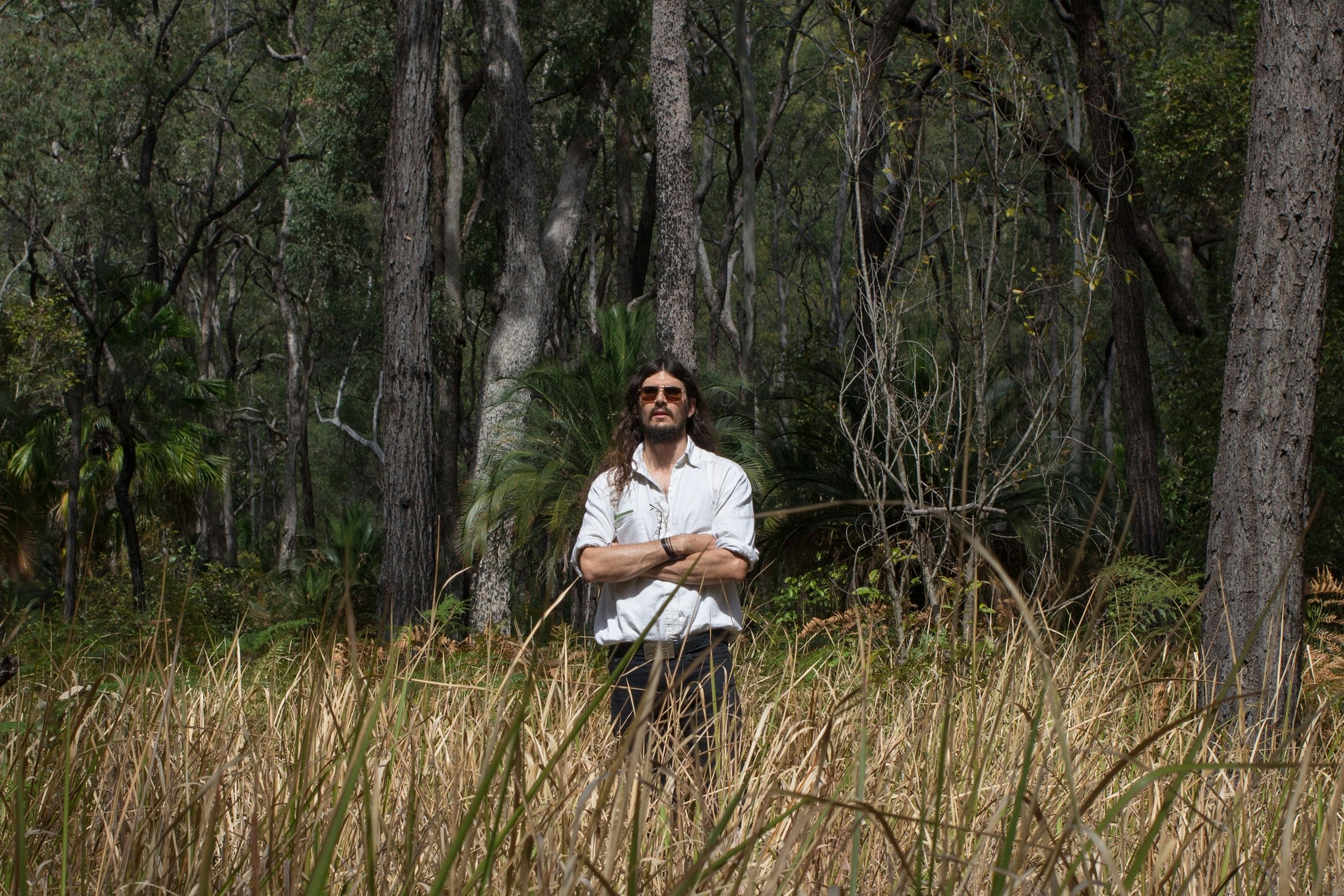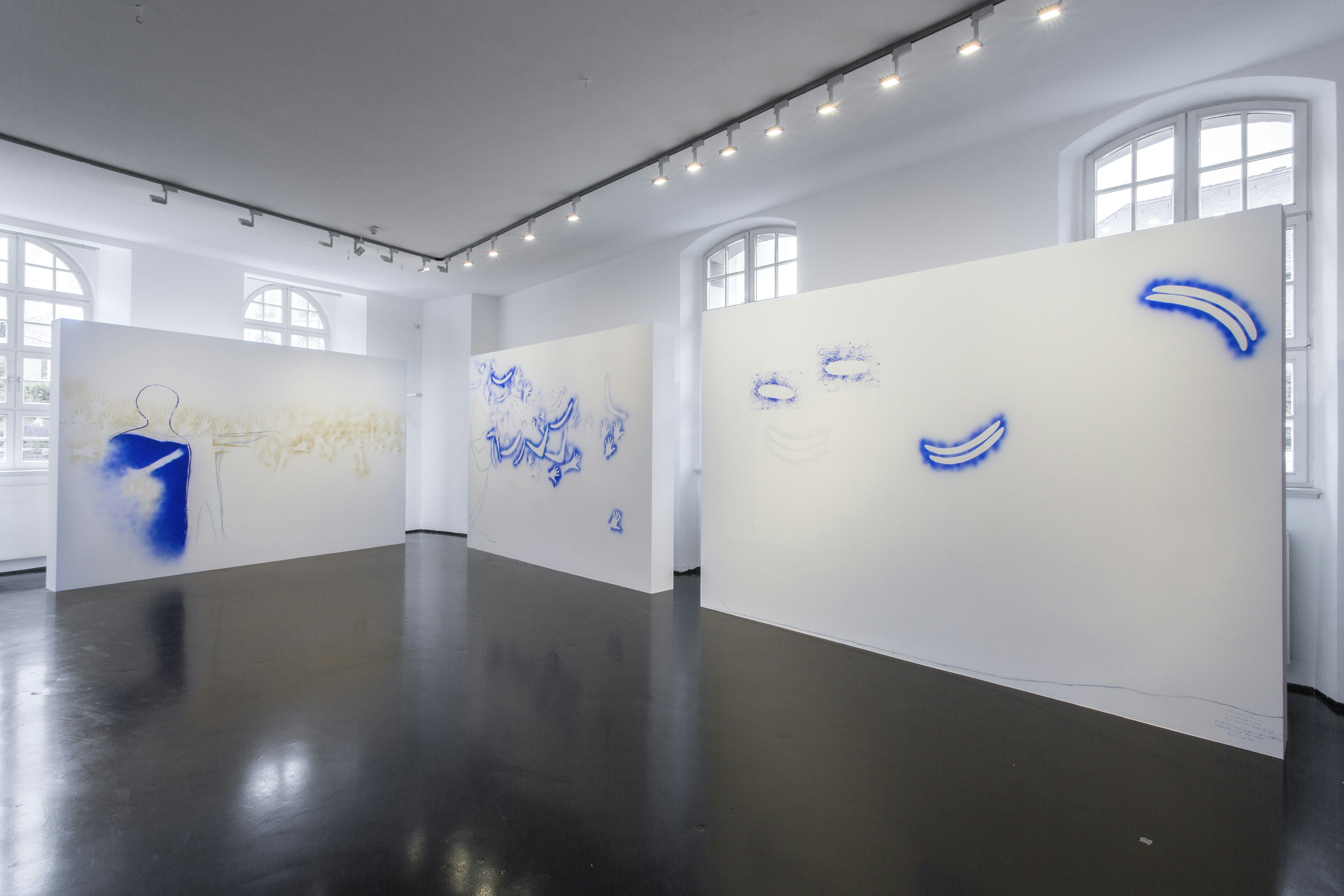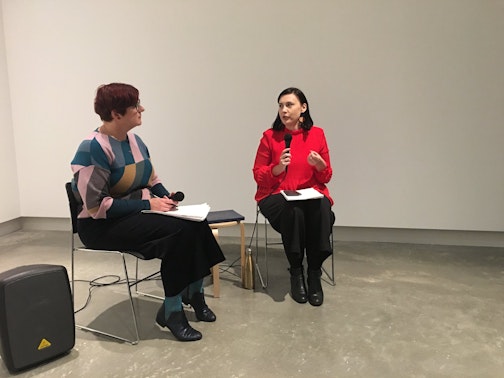Honouring cultural continuum with Dale Harding
Tess Maunder

Dale Harding, 2015; photo: Karen Lawton, courtesy the artist and Milani Gallery, Brisbane.
Brisbane, or Meanjin is the traditional home to Turrbal and Yugara (Jagera) peoples. Geographically the city is demarcated by the large brown river or Maiwar that winds throughout the topography, framing the landscape with its snake-like body. The subtropical humidity in the city gives way to a certain porosity where political conversations that are only just beginning to happen in Australia’s more southern states have been marked out in Brisbane decades before. Historically, Brisbane’s art ecology has endured periods of what might be described as repressive funding framework and government policy. Yet, despite this reality, artistic activity has flourished, and one might describe the city as spirited, collaborative, political and loyal. In Brisbane, this manifests through a strong focus on the practices of First Nations artists, a growing awareness and developing visual literacy for practices representing voices from Asia Pacific, a strong LGBTIQ+ arts community alongside feminist discourses, and a stoic grass-roots artist-run scene that feeds into the many constellations that make up the city.
Where Brisbane often loses out, however, is in its visibility in both national and international contexts. In Australia, as in most nation-states, when it comes to culture there is a focus of cities that represent ‘the centre’ and this most often signals Sydney and Melbourne. Visibility for artists from Brisbane has been an ongoing issue with many artists, despite demonstrating a strong community connection in the city, feeling pressured to move interstate to further develop their careers. Of course, there is no right or wrong pathway, and what will work for each practitioner is different—yet this ‘brain drain’, as it has often been described, is an ongoing issue for the city’s art community. That is precisely why it is so encouraging to see an artist such as Dale Harding garner the visibility that his artistic practice deserves, all while maintaining his connection to community, family and country in Brisbane and wider Queensland.

Dale Harding and Jordan Upkett, Wall Compositions from Memory (installation view), 2018, TarraWarra Museum of Art, TarraWarra Biennial 2018: From Will to Form; photo: Andrew Curtis, courtesy the artist and Milani Gallery, Brisbane.
Dale Harding was born in 1982 in Moranbah, Australia. He is a descendant of the Bidjara, Ghungalu and Garingbal peoples of country that is now recognised as Central Queensland. Harding has achieved an impressive career trajectory for an emerging artist which has been achieved both on his own terms and outside of the standardised Sydney and Melbourne channels of exchange. For instance, Harding’s work has been shown in the 11th Gwangju Biennale (2016), documenta 14 (2017), and the 10th Liverpool Biennale (2018). Closer to home, his work has been included in major Australian exhibitions including Defying Empire: 3rd National Indigenous Art Triennial, National Gallery of Australia, Canberra (2017); The National: New Australian Art, Art Gallery of New South Wales, Sydney (2017); and TarraWarra Biennial 2018: From Will to Form, TarraWarra Museum of Art, Healesville, Victoria.
Harding’s practice can be defined by his sincere, sensitive and nuanced approach to materiality and process. This basis forms the framework for viewers to engage with the artist’s ongoing enquiries into the enduring political, social and oral histories of both his family and wider community. Unlike many of his contemporaries, Harding often honours and draws homage to matrilineal female figures in his family, engaging and bringing forth their gender-specific stories. How this has been communicated is often through a particularly sensitive approach to materiality, focusing on quietly powerful binary compositions, object orientated ontology and negative space.
Harding’s practice has a strong focus on community, family and place, a layered mesh that guides his approach to making and research. This grounding force feeds into more than the artist’s actual work; importantly it provides the primary platform and then axis for his work to travel further abroad. Harding is a graduate of the Queensland College of Art’s Contemporary Australian Indigenous Art Program, graduating from his Honours degree in 2013. The program syllabus was written by artist and academic Jennifer Herd, founding member of the Indigenous arts collective ProppaNOW. Founded in 2003 by core members Richard Bell, Jennifer Herd, Joshua Herd and Vernon Ah Kee, ProppaNOW formed to address the critical lack of ‘proppa’ engagement with First Nations urban artists. Members of the collective have changed and shifted over its continuation and yet ProppaNOW has undoubtedly maintained a huge impact on the Brisbane community and has paved the way for future First Nations run collectives and frameworks. This includes, for instance, Blaklash Collective, co-founded and directed by Katina Davidson, Freja Carmichael and Amanda Hayman in 2016.
Continuing in this framework of inter-generational sharing is artist Tony Albert, one of Harding’s other earliest supporters. Albert is a widely recognised and celebrated First Nations artist who also graduated from Queensland College of Art. A mentorship between the two was organised through the channels of the art school when Harding was a student. Following this, as a curator Albert included Harding in a number of group exhibitions including Pay Attention, City Gallery Wellington (2010) and unDISCLOSED: National Indigenous Art Triennial, National Gallery of Australia, Canberra (2012). Albert also curated a solo exhibition of Harding’s work in an exhibition called Colour By Numbers at Brisbane’s Metro Arts in 2012. From here Harding had a solo exhibition named White Collared at the Institute of Modern Art (IMA) in 2015 and this introduction put the artist in conversation with many international collaborators following introductions made by IMA directors Aileen Burns and Johan Lundh to their network, setting the scene for further national and international stagings of the artist’s work. This nuanced balance between practice and career trajectory, I think is relevant to acknowledge.

Dale Harding, White Collared, 2013, found collars, rawhide, thread and brass, 190 x 38 x 2 cm (dimensions variable); courtesy the artist and Milani Gallery, Brisbane.
Returning to practice, Dale Harding’s material investigations can be divided into three different formal approaches: sculptural-based works, wall-mounted works, and work demarcated directly on walls themselves. Each approach has been explored and worked through over the past decade but here I will focus specifically on Harding’s wall painting works which are considered acts of cultural continuum by the artist and his family.
Oral histories from Harding’s family are informed by a very specific history of loss, dehumanisation and cultural genocide on their traditional country. These cruel acts were carried out by the government of Queensland through the Aboriginals Protection and Restriction of the Sale of Opium Act 1897 and subsequent amending acts. This law provided the framework for the state’s government to exercise control over all aspects of the lives of Aboriginal and Torres Strait Islander people in Queensland through a variety of means, the primary one being the forced removed of First Nations Australians from their lands, community and family. Members of Harding’s family were forcibly removed to a so-called ‘reserve’ named the Woorabinda reserve, located near present day Rockhampton. The reserve, like many in Australia, festered in cultural genocide, family separation and colonial ‘re-education’ through labour. For Harding’s family specifically, three generations of women—his mother, grandmother and great-grandmother—were forcibly engaged as domestic servants in Queensland. This act of violence against Harding’s family was part of a larger framework of gendered servitude where women and girls undertook unpaid domestic labour in rural farms and homesteads in Central Queensland, and indeed wider Australia.
Harding respectfully draws from these histories in his work. He weaves sobering accounts of his family’s histories alongside and in conversation with powerful symbology representing ongoing cultural continuum for his family and wider community. He does this by paying homage to rock art painting as an ongoing cultural practice for his family, community and wider First Nations Australians, through his own wall paintings that express the artist’s connection to traditional country at Carnarvon Gorge in Central Queensland. Elaborating on this aspect of his work, Harding says:
Much of my grandparents’ countries falls under the bounds of Carnarvon National Park, and we continue an unbroken connection to those places. My work as an artist and as a researcher is only one extension of this cultural continuum, and my family and I view my/own work as contributing to the canon of our cultural production. The countless sandstone rock art galleries and natural spaces out on my grandparent’s countries colour my sensibility as an artist (1).
Harding asserts a powerful dignity into a history widely written by the oppressor. Through his practice and engagement with community he demonstrates the strength of the members of his family for enduring such history and trauma, and places this conversation with symbolic and ongoing cultural practice of Indigenous rock art.

Dale Harding, Composite Wall Panel: Reckitt’s Blue (installation view), 2017, silkscreened prints with mural prints, ochre and Reckitt’s Blue; photo: Roman Maerz, Naturkundemuseum Im Ottoneum, Kassel, courtesy the artist and Milani Gallery, Brisbane.

Dale Harding, Composite Wall Panel: Reckitt’s Blue (detail), 2017, silkscreened prints with mural prints, ochre and Reckitt’s Blue; photo: Roman Maerz, Naturkundemuseum Im Ottoneum, Kassel, documenta 14, courtesy the artist and Milani Gallery, Brisbane.
In 2016, Harding worked collaboratively with family to make wall-based work for his solo exhibition I Refuse You My Death at Milani Gallery in Brisbane. The exhibition, comprising several elements, featured a work devised by mouth-blown ochre that stretched across two white walls in the gallery space. Harding stencilled a rifle, representing a colonial presence, whose relief form pointed toward a visual gathering of stencilled hands. Other elements included an extraction of the actual gallery wall; a taking away, excavating a thin layer of the wall in form of a charted line. This was the first instance of Harding producing a wall-based work with ochre from country and this work became the basis of works that continued elsewhere around the world.
This engagement with a similar wall-based practice utilising mouth-blown ochre has been an ongoing method of enquiry by the artist in other stagings around Australia, such as the work Know them in correct judgement (2017) presented as part of The National at the Art Gallery of New South Wales. Similar to his exhibition at Milani, this work assembled objects against a background of mouth-blown ochre that traced the shape of two fighting sticks, a wall-painting that was produced with Harding’s uncle Milton and cousin Will. Harding extended the work’s conceptual engagement via the introduction of Reckitt’s Blue, a synthetic ultramarine and sodium bicarbonate laundry whitener first produced in 1852 by Reckitt & Sons in Hull, England, that was marketed and used widely throughout the British colonies especially and therefore, as used by the artist, redolent of a symbolic power that is primarily grounded in the labour of female domestic servants. Harding’s combination of Reckitt’s Blue with ochre was first staged at the Queensland Art Gallery and Gallery of Modern Art (QAGOMA) in a major work commissioned for the opening of the institution’s new Contemporary Australian galleries. Wall Composition in Reckitt’s Blue (2017), a striking combination of earthy orches against the vivid blue of the ultramarine pigment, symbolically entangled the oppressor and the oppressed through its approach to materiality; presenting more than a simple binary opposition, it is a striking restaging and repositioning of voice, a vivid push by Harding to activate cultural continuum, to acknowledge the traumas, and to say: we are still here. This was an especially important moment in context of the Contemporary Australian galleries at Queensland Art Gallery and the Gallery of Modern Art. This is because the new staging of the collection openly embraced avoiding a Western anthropological style of hang and instead opted for an open constellation portraying the multiplicities of contemporary Australian at once. In this sense, Harding’s work at QAGOMA was an anchor in the new collection hang, uniting multiple histories and perspectives of contemporary Australia.

Dale Harding, Wall Composition in Reckitt’s Blue (installation view), 2017, Reckitt’s Blue laundry powder, charcoal and Grevillea robusta resin, incision into wall; commissioned 2017 with funds from anonymous donors through the Queensland Art Gallery | Gallery of Modern Art Foundation; photo: Natasha Harth, Queensland Art Gallery, 2017,courtesyQAGOMA.
These initial stagings in Australia fed into Harding’s work at documenta 14 (2017) and, more recently, for the 2018 Liverpool Biennial, Beautiful world, where are you? For Liverpool in particular, the composition between Reckitt’s Blue and traditional ochre from country held another layer: presented beyond the Australian continent Harding embraced the opportunity to hold a global conversation about unpaid labour and the varying traces that this has taken across the globe. In addition to First Nation politics, it is apparent that through Harding’s works wider intersectional connections can also be made. These include potential conversations surrounding class, as seen for example in his Liverpool work, engaging with the working class history of the city; and wider international First Nations cultural continuum through the opening up of his work at documenta 14; and subsequent international and intersectional conversations regarding genocide, the value of female labour, and maintaining the fight for cultural continuum through sovereignty. Looking forward, Harding is about to open his solo exhibition The Drive Home at Milani Gallery that will focus on work developed during the artist’s residency at Iaspis, Stockholm. In 2019, Brisbane’s IMA will present Dale Harding: Current Iterations, a survey exhibition that is a response and partnership with Harding’s recent staging at the 2018 Liverpool Biennial. It is pertinent, now more than ever, to continue to be reminded of the lived reality of these histories.
Dale Harding is an artist highlighting First Nations histories in unseeded territories in Australia from his position as a proud Bidjara man. Harding reminds us of the very real reality of these histories and the intergenerational trauma that cruel actions have caused First Nations communities in this country. Further, through the development of his contextualised practice and career Harding makes a case for artists to stay in Brisbane. He has proven that is it possible to contribute to his community while carving out international exhibition and residency opportunities. Brisbane—a city, a community, a family—has provided the praxis that a talented, engaged and serious artist like Harding needed to propel his practice, ideas and stories into the international spotlight on his own, dignified terms.
About the contributor
Tess Maunder is a curator, educator and arts writer currently based in Brisbane, Australia.
